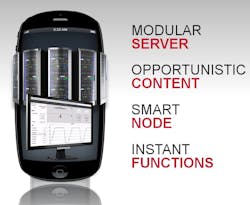We’ve been hearing Rockwell Automation talk about the Connected Enterprise for a few years. During that time, it has built out an ecosystem of partners and upgraded technology across its three core platforms: Integrated Architecture, Intelligent Motor Control, and Solutions and Services.
Last week at Rockwell Automation TechEd in San Diego, the company took this concept to a whole new level, revealing behind-the-scenes work it is doing on a mobile framework that will behave as the connective tissue in a highly integrated controls infrastructure.
“Within Rockwell there is an acceleration to move from product-centric to system-centric,” says Ryan Cahalane, the company’s director of software product management for the control and visualization business. “There is so much in the portfolio that is locked away behind the walls of the individual products.”
To unlock the value that already exists in its product portfolio, Rockwell is working on ways to create context at the source and provide awareness across systems while maintaining a secure automation environment that includes authentication and policy management, tamper protection and content protection.
Rockwell’s programming software Studio 5000 is a key element in the effort to expose system data hidden away in controllers and drives. Last year, Studio 5000 – which has been the primary development environment for the Logix controller-- matured into an integrated development tool for the overall product portfolio. It is becoming an “anchor point” for new mobile designs using custom objects that can be stored in libraries, and a consistent user interface that snaps into the same framework.
That framework, called the Mobile Foundation Toolkit (MFT) is the other key element here, and the secret ingredient of Rockwell’s communication evolution. MFT includes libraries of components that use AngularJS (by Google), Bootstrap (an open source toolkit for developing “mobile first” applications), and HTML5. These contemporary tools make a web-based responsive design that enables users to do things interactively across different pieces of “glass” (phone, tablet, desktop).
“This gives the user the ability to decorate the data and make it available, but it is not forcing the user to organize the data,” says Kyle Reissner, Rockwell’s Integrated Architecture mobility platform leader.
Studio 5000 is what enables the “data decorating” by adding context, intelligence, and modularity at the device layer to make the control system that much smarter—without doing a major upgrade. MFT enables the “mash up” of relevant data and extends its reach, using personal workflows, to where—or who-- it needs to go to.
So how does all of this work? Good question, as it is still evolving, but Reissner and Cahalane seem very clear and confident as to how this will play out. And it all starts with that super computer in your pocket, the smartphone.
Think about the fact that we already layer on context to digital photos, for example, by adding time stamps and even geolocation. Now there is additional value without actually changing the asset. On the factory floor, the phone can act as a smart node, pulling data together to pair performance of a drive with a batch record. Or, maybe there is weather-related data embedded into devices in the field.
One of many use cases that Rockwell is developing under the code name Project Stanton (a hat tip to Stanton Allen, a founding father of the original Allen-Bradley industrial controls company that launched in 1903) is an easier way to collaborate on the plant floor. People use consumer apps like iMessage or WhatsApp to communicate directly, but there may not be Wi-Fi in the plant, so Rockwell is developing what it describes as a peer-to-peer opportunistic engine providing hyprid connectivity.
“We are experimenting with mesh technology, so if all users, including machines, are in a paired group, the messages hop in a secure, encrypted way across all the users to get to their destination,” Reissner says. Opportunistically, the data replicates in the background – even using devices and machines in the chain—until it gets to the end user.
And just as important is the accessibility of the technology. There would be no server to install, just download the app from the Rockwell Automation App platform.
Development of this new mobile technology is well underway. The goal is to create a modular architecture in which products and apps click in and deliver opportunistic content as soon as systems are connected, turning a phone from a dumb client into a smart node on the network.
“We can’t find this off the shelf, and our teams are working very hard to invent some of this technology,” Reissner says.
If Rockwell can deliver on their vision for this next-generation of industrial mobility, it could potentially change the way people and things communicate on the factory floor, and bring new meaning to the connected enterprise.
About the Author
Stephanie Neil
Editor-in-Chief, OEM Magazine

Leaders relevant to this article:
